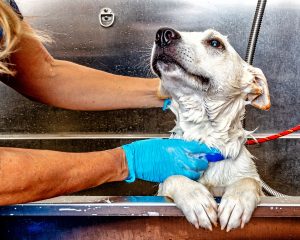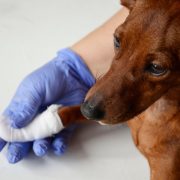Down-the-drain pathways for fipronil and imidacloprid applied as spot-on parasiticides to dogs: Estimating aquatic pollution
Down-the-drain pathways for fipronil and imidacloprid applied as spot-on parasiticides to dogs: Estimating aquatic pollution

Open access
In our edition of: Apr 2024
In our categories of: small animals
our summary:
Perkins, R. et al. (2024) Down-the-drain pathways for fipronil and imidacloprid applied as spot-on parasiticides to dogs: Estimating aquatic pollution. Science of The Total Environment, 917, 170175.
The aim of this study was to test the hypothesis that fipronil and imidacloprid applied as veterinary spot-on treatments can pass down-the-drain through owner handwashing, bed washing and bathing of dogs, and that emissions via these pathways could represent substantial pollution sources in aquatic environments.
The study, which was supported by the Veterinary Medicines Directorate, was carried out at the University of Sussex and Imperial College, using a population of dogs whose owners had volunteered to take part in the study that attended a UK veterinary hospital. Healthy dogs that had not been treated with a parasiticide product containing fipronil or imidacloprid within the preceding three months were eligible for inclusion. Enrolled dogs were randomly treated, by a veterinary surgeon, with either Frontline Spot-on Dog 10 % w/v Spot on Solution or Advocate Spot-on Solution. As part of the study protocol each dog was provided with a 30mm pile polyester bed. To assess persistence of residues on bedding, 12 unused beds were spiked with 0.2ml of Advocate and Frontline spot on. These beds were washed at 1-, 2- and 3-month intervals.
After treatment dogs returned to the veterinary surgery on day 5, 14 and 28 post application for collection of handwash, bathing and bed laundering samples which were collected following standardised methods. For all sampling the entirety of water used was collected. Samples were analysed for both imidacloprid and fipronil, providing reciprocal controls. Wash-off percentages for active ingredients from individual wash-off events and population emissions fractions (PEF), defined as the proportion of total applied spot-on product emitted via a defined pathway from a population, were calculated.
Data on measured imidacloprid and fipronil concentrations in wastewater influent and effluent, and upstream and downstream, of wastewater treatment works were obtained from the 3rd UK Water Industry Research Chemical Investigation Program (CIP3) Report, Volume 5.
There were 98 dogs included in the study, 50 dogs were treated with Frontline Spot-on Dog and 48 dogs with Advocate Spot-on Solution. Results showed that fipronil and imidacloprid were detected in all wash-off samples – bathing, bed washing and handwashing. Wash-off percentages decreased significantly with days post application for bathing and handwashing, post-application interval had no significant effect on wash-off from the beds of dogs treated with imidacloprid or fipronil or from the beds that had been spiked with imidacloprid and fipronil.
Handwashing resulted in the highest PEF, accounting for an estimated 4.9 % of imidacloprid and 3.1 % of fipronil applied in spot-ons passing down-the-drain. Bathing and bed washing resulted in PEFs of 3.1 % and 1.1 % for imidacloprid, and 1.9 % and 1.0 % for fipronil, respectively.
Imidacloprid and fipronil were detected in wastewater effluent at all sites. Imidacloprid concentrations downstream of wastewater discharge points were significantly higher than those upstream. Fipronil was detected in 1 out of 12 upstream sites and 8 out of 12 downstream sites.
Limitations of the study are that the limited availability of data resulted in some assumptions that may underestimate or overestimate emissions for the pathways examined.
This study provides some evidence that fipronil and imidacloprid applied as spot-on treatments for dogs can pass down-the-drain and contribute to aquatic pollution. The study highlights the need for further research and for consideration of further regulation in this area to protect the environment.
The following may be of interest:
InFOCUS: Veterinary medicines and the environment [RCVS Knowledge] [online] Available from: https://infocus.rcvsknowledge.org/vme_veterinary-medicines-and-the-environment/ [Accessed 11 April 2024]
InFOCUS: Responsible use of antiparasitic medications in veterinary practice [RCVS Knowledge] [online] Available from: https://infocus.rcvsknowledge.org/ruam-responsible-use-of-antiparasitic-medications-in-veterinary-practice/ [Accessed 11 April 2024]
Shotton, J. (2024) Parasiticides in dogs and cats: a risk based approach. The Veterinary Nurse, 15 (4), pp. 138-140. https://doi.org/10.12968/vetn.2024.0024
Claiming CPD for reading inFOCUS articles
Reading and reflecting on articles can count towards your CPD, and we have a template to help you with the process.
Image copyright attribute: adogslifephoto







Leave a Reply
Want to join the discussion?Feel free to contribute!